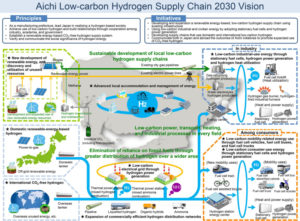Ammonia as a Hydrogen Carrier for Hydrogen Fuel Cells
By Stephen H. Crolius on October 18, 2018
In the last 12 months …
Consider the attributes that characterize a good hydrogen carrier: liquid state at ambient conditions; high volumetric and gravimetric energy density; low propensity to create lethal hazards when transported, stored, and used. Now consider that ammonia is superior to hydrogen itself in every one of these areas. Given this, it stands to reason that proponents of hydrogen fuel cells should embrace ammonia as a valuable enabling technology that can elevate the feasibility and improve the economics of fuel-cell-based systems. And indeed this embrace became evident over the last year.
Ammonia Energy reported on three major developments in this arena in 2018. The first was Toyota Motor Corporation’s announcement of a multi-stakeholder plan to develop a hydrogen energy economy in its home region – with ammonia explicitly included as a carrier of hydrogen for consumer-oriented fuel cell applications in both transportation and the built environment.
The second was the announcement by Japanese electrical manufacturer Sawafuji that it had an explicit plan to commercialize a high-purity ammonia-to-hydrogen conversion system whose original development was carried out at Gifu University. The announcement’s mention of 2020 as the target date for bringing the system to market shows that Toyota’s embrace of ammonia as an energy carrier is taken as a bona fide business opportunity within corporate Japan.
The third was the demonstration by Australia’s Commonwealth Scientific and Industrial Research Organization of its own high-purity ammonia-to-hydrogen conversion system that has been designed for use at hydrogen fueling stations. Partners in CSIRO’s project include BOC (a subsidiary of global industrial-gas powerhouse Linde Group) and Toyota and Hyundai, who supplied a Mirai and a Nexo, respectively, for the demonstration.
Hydrogen fuel cells are not a possibility of the future. They are a technology of the present, especially in Japan. It is heartening to see that they will become a near-term use case for ammonia energy.
Ammonia Energy reporting on this topic since last year
- May 3, 2018: Toyota Supports H2 Society Roll-Out on Its Home Turf; Sees Role for NH3
- June 14, 2018: Sawafuji Moves toward Commercialization of NH3-to-H2 System
- August 16, 2018: CSIRO Demonstrates Ammonia-to-Hydrogen Fueling System
A year in review
To mark the second anniversary of Ammonia Energy, we are reviewing the most important stories from the last 12 months. This “top ten” list spans two areas: five are significant advances that build on activities that were already underway in 2017, and five are new developments that emerged decisively this year.
Significant advances:
- Ammonia as a Grid-Supporting Energy Storage Solution
- Ammonia as a Hydrogen Carrier for Hydrogen Fuel Cells
- Maritime Industry Targets Ammonia Fuel to Decarbonize Shipping
- Ammonia as a Direct Fuel for Alkaline and Solid Oxide Fuel Cells
- Great Strides in NH3 Commitment and Progress in Australia
New developments:
- Green Ammonia Plants, Commercially Available Today
- Ammonia Is Taken Up by Wide-Circulation Media
- Targets, Limits, Pledges, Bans: Enforcing the Transition to Sustainable Energy
- Affiliated NH3 Groups Become a Force for Advocacy
- Fossil Energy Companies Turn to Ammonia
